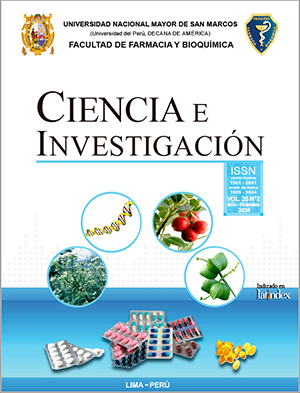Evaluation of the Effect of Salvia hispanica L. “chia” Seeds on the Glycemic Level of Female University Students
DOI:
https://doi.org/10.15381/ci.v26i2.25996Keywords:
Salvia hispanica L., chia, hypoglycemic effect, diabetesAbstract
To evaluate the effect that chia seeds (Salvia hispanica L.) have on postprandial glycemia levels in young healthy female university students, an experimental study is proposed where the participants were 25 healthy young female university students, aged 19 to 26 years. and no family history of diabetes. On different days, 50 g of glucose diluted in table water (first administration) and 50 g of glucose with 30 g of chia (second administration) were administered orally. Subsequently, peripheral blood glucose was measured at 0, 30, 60, 90 and 120 minutes. The results showed that the administration that included chia seeds managed to significantly reduce the postprandial glycemic curve compared to the control with glucose, especially at minutes 60, 90 and 120. The area under the glycemic curve that includes the administration of chia was 20.2% lower than the control with glucose and the maximum glucose peak decreased by 14.5%. In conclusion, the consumption of chia significantly reduces blood glucose indicators such as the postprandial curve, area under the curve (p<0.05) and maximum increase in glucose (p<0.05), so it can be used as a functional food due to its hypoglycemic activity.
Downloads
Published
Issue
Section
License
Copyright (c) 2024 Vidalina I. Heredia, Mario Alcarraz, Mirtha M. Yarlequé, Americo J. Castro, Norma J. Ramos

This work is licensed under a Creative Commons Attribution 4.0 International License.
LOS AUTORES RETIENEN SUS DERECHOS:
- Los autores retienen sus derechos de marca y patente, y tambien sobre cualquier proceso o procedimiento descrito en el artículo.
- Los autores retienen el derecho de compartir, copiar, distribuir, ejecutar y comunicar públicamente el articulo publicado en la Revista Ciencia e Investigación (por ejemplo, colocarlo en un repositorio institucional o publicarlo en un libro), con un reconocimiento de su publicación inicial en la Revista Ciencia e Investigación.
- Los autores retienen el derecho a hacer una posterior publicación de su trabajo, de utilizar el artículo o cualquier parte de aquel (por ejemplo: una compilación de sus trabajos, notas para conferencias, tesis, o para un libro), siempre que indiquen la fuente de publicación (autores del trabajo, revista, volumen, numero y fecha).






